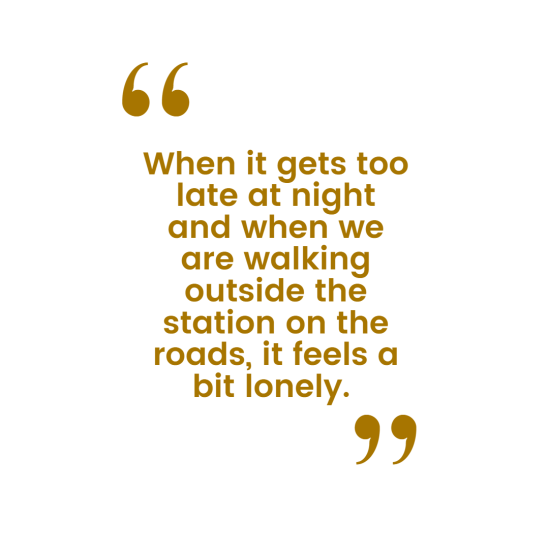Mumbai's Last Mile Challenge

Mumbai's Last Mile Challenge
As part of the C40 Cities Women4Climate project, this blog post presents a few peculiar observations, and reflections on the last mile connectivity of the qualitative interviews conducted as a part of Gendered, Mobility and Climate Action research.
The interviews shed some light on the nuances of the intersection between informality, transit and gender. Upon closer inspection, we could observe some patterns emerge in women’s patronage of informal transit options. Apart from walking, informal transit options (also called paratransit or intermediate public transit) such as auto-rickshaws, and share-autos were among the most used modes to fulfil the last mile connectivity (or here, disconnectivity). Some women had to wait a considerable amount before boarding an auto-rickshaw, while others cited a sense of “loneliness” while walking home on footpaths, with scant lighting.
Informality pervades the Indian urban experience and presents itself in almost all spheres - housing, employment and even transit. It is a quintessential feature of Indian cities (Singh, 2018) and thus emerges as a set of organic solutions to inorganic problems in an attempt to bridge key infrastructure and service delivery gaps. According to the National sample survey office, auto-rickshaws are used by around 38% and 40% of the households in rural and urban areas in India in the year June 2014–2015, respectively (NSSO, 2016).
Safety: A common theme of gendered mobility
Safety is one of the main determinants compelling women to take more shared modes. One respondent chimes in, "When it gets too late at night and when we are walking outside the station on the roads, it feels a bit lonely.” Another respondent has similar sentiments, though she talks about how the trains also are equally unsafe, “There are a lot of problems being a woman. And the kind of dress that we wear (becomes a big issue) so you find many such kinds of people in the station also, touching you.”
Women have had to forego seemingly easier options to ensure safety. One respondent, a full-time employee in her mid-thirties claims, “Actually I know how to ride a bike and initially, that was my first priority but due to so much traffic and how the highway is not safe for bike users, that is why I don’t take that risk. My family does not allow me. Otherwise, I would have chosen the bike It is a bit risky to ride a bike, especially in the mornings.” This sentiment can be found in the apprehension towards infrastructure for last-mile connectivity too. However, within this pattern there exist striated experiences, marked by the respondents’ class (and caste) locations. This is a testament to how among women, the way each of them perceives and travels varies with their social location, giving rise to different and often conflicting opinions. For example, one respondent lamented the poor state of bus stands and claimed, “If you see, there are more beggars sleeping over there. It's not very safe even during the night. Although there's an infrastructure given, there's no such safety or it's not used to its maximum.” Her statement can be considered a reflection of her biases and attitudes towards beggars, and qualitative data is not immune to such phenomena. On the other hand, one respondent preferred to stay nuanced and said, “If we look at it another way, women are a little scared but they are also bindaas (carefree). So right now it feels good, especially as a woman. For women who go out to work at night, that fear has reduced a bit.” So how do they cope with this fear? One respondent says, “Every day, twice in the morning and also any evening, when I reach the office and when I leave the office, I need to make a call to my home and tell them that I have left and in the morning I have reached.”
Autos and uncertainty
Another major issue was the unpredictable nature of intermediate public transit mode. One would expect that with a considerably higher fleet of auto-rickshaws, share-autos and even cycle-rickshaws (as compared to buses), the frequency would also be reliable. But these modes are often unreliable and the drivers accept ride requests differentially. One respondent complains, “Sometimes the auto-rickshaws do refuse. It happens frequently in Masjid, JJ Hospital (Sandhurst Road). If there is a medical emergency and we must go to the hospital, sometimes taxis and auto-rickshaws refuse to go. They don’t want to travel nearby, they want to go for longer distances. So it becomes a problem then.” Another respondent contradicts and explains how autos depend on their proximity to railway stations, “If the station is nearby, we get autos quickly, but if it is farther, we don’t get as many autos.” The problem gets compounded when taking shared autos. One respondent says, “In shared auto-rickshaws, we have to wait till everybody gets a seat. So I have to wait for that, and near some stations, one has to wait for the auto-rickshaws. Many times I have had to wait a lot.”
The climate change connection
Last-mile connectivity is a crucial component for increasing accessibility and often acts as a litmus test for people considering whether to travel through public transport or not. Therefore, it is imperative to have robust last-mile connections. While increasing safety is a prime concern in ensuring more women take up public transit, one quantitative implication of having dense intermediate transit networks is the considerable reduction of carbon emissions. The combination of LPG-driven autos and sharing of modalities has the potential to decrease carbon emissions further. Smaller, more decentralized networks can penetrate deeper into neighbourhoods with higher densities and regions that lie at the periphery of cities. Given the unique intersection between women’s mobility patterns, intermediate transit modes can also be leveraged to make their daily routines easier - stopping at grocery shops, bazaars and chowks en route to their homes.
References
- Kumar, M., Singh, S., Ghate, A. T., Pal, S., & Wilson, S. A. (2016). Informal public transport modes in India: A case study of five city regions. IATSS Research, 39(2), 102-109. https://doi.org/10.1016/j.iatssr.2016.01.001
- Singh, B. (2018). Informality: The Quintessential Feature of Indian Urbanism. Knowledge and News Network.
- National Sample Survey Organisation, India. (2016).




